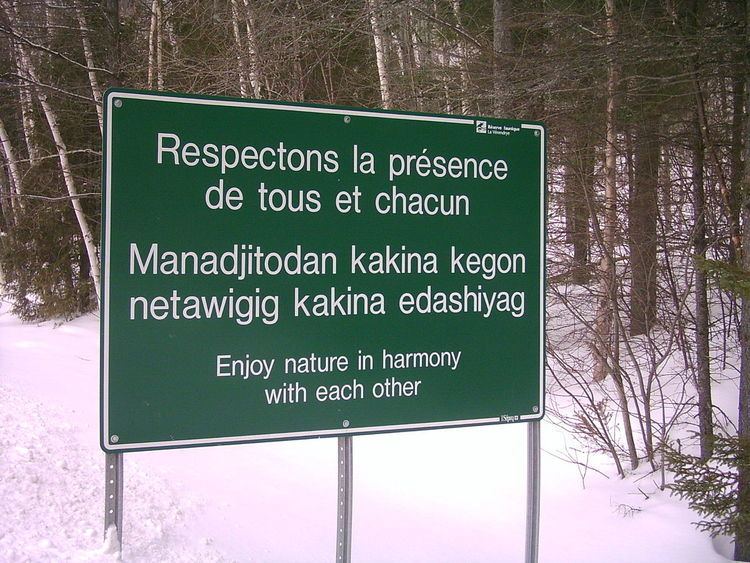ISO 639-3 alq | Native speakers 1,800 (2011 census) Glottolog algo1255 | |
 | ||
Language family AlgicAlgonquianCentralAnishinaabeAlgonquin | ||
Algonquin (also spelled Algonkin; in Algonquin: Anicinàbemowin or Anishinàbemiwin) is either a distinct Algonquian language closely related to the Ojibwe language or a particularly divergent Ojibwe dialect. It is spoken, alongside French and to some extent English, by the Algonquin First Nations of Quebec and Ontario. As of 2006, there were 2,680 Algonquin speakers, less than 10% of whom were monolingual. Algonquin is the language for which the entire Algonquian language subgroup is named. The similarity among the names often causes considerable confusion. Like many Native American languages, it is strongly verb-based, with most meaning being incorporated into verbs instead of using separate words for prepositions, tense, etc.
Contents
Classification
Algonquin is an Algonquian language, of the Algic family of languages, and is descended from Proto-Algonquian. It is considered a particularly divergent dialect of Ojibwe by many; it acts as a transitional language between the Ojibwe languages and the Abenaki languages. But, although the speakers call themselves Anicinàbe ("Anishinaabe"), the Ojibwe call them Odishkwaagamii (those at the end of the lake). Among the Algonquins, however, the Nipissing are called Otickwàgamì (the Algonquin orthography for the Ojibwe Odishkwaagamii) and their language as Otickwàgamìmowin. The rest of the Algonquin communities call themselves Omàmiwininiwak (down-stream men), and the language Omàmiwininìmowin (speech of the down-stream men).
Other than Algonquin, languages considered as particularly divergent dialects of the Anishinaabe language include Mississauga (often called "Eastern Ojibwe") and Odawa. The Potawatomi language was considered a divergent dialect of the Anishinaabe language but now is considered a separate language. Culturally, the Algonquin and the Mississaugas were not part of the Ojibwe–Odawa–Potawatomi alliance known as the Council of Three Fires. The Algonquins maintained stronger cultural ties with the Abenaki, Atikamekw and Cree.
Among sister Algonquian languages are Nitsitapi, Cheyenne, Cree, Fox, Menominee, Potawatomi, and Shawnee. The Algic family contains the Algonquian languages and the so-called "Ritwan" languages, Wiyot and Yurok. Ojibwe and its similar languages are frequently referred to as a "Central Algonquian" language; however, Central Algonquian is an areal grouping rather than a genetic one. Among Algonquian languages, only the Eastern Algonquian languages constitute a true genetic subgroup.
The northern Algonquin dialect of Anishinabemowin as spoken at Winneway, Qc (Long Point) and Timiskaming First Nation, Qc is a similar dialect to the Oji-Cree dialect (Severn/Anishininimowin) of northwestern Ontario, despite being geographically separated by 800 km as the crow flies.
Dialects
There are several dialects of the Algonquin language . Speakers at Maniwaki consider their language to be Algonquin, though linguistically it is a dialect of Eastern Ojibwa.
Consonants
The consonant phonemes and major allophones of Algonquin in one of several common orthographies are listed below (with IPA notation in brackets):
Aspiration and allophony
The Algonquin consonants p, t and k are unaspirated when they are pronounced between two vowels or after an m or n; plain voiceless and voiceless aspirated stops in Algonquin are thus allophones. So kìjig ("day") is pronounced [kʰiːʒɪɡ], but anokì kìjig ("working day") is pronounced [ʌnokiː kiːʒɪɡ].
/h/ can be pronounced as either [h] or [ʔ].
Diphthongs
Nasal vowels
Algonquin does have nasal vowels, but they are allophonic variants (similar to how in English vowels are sometimes nasalized before m and n). In Algonquin, vowels automatically become nasal before nd, ng, nj or nz. For example, kìgònz ("fish") is pronounced [kiːɡõːz], not [kʰiːɡoːnz].
Stress
Word stress in Algonquin is complex but regular. Words are divided into iambic feet (an iambic foot being a sequence of one "weak" syllable plus one "strong" syllable), counting long vowels (à, è, ì, ò) as a full foot (a foot consisting of a single "strong" syllable). The primary stress is then normally on the strong syllable of the third foot from the end of the word—which, in words that are five syllables long or less, usually translates in practical terms to the first syllable (if it has a long vowel) or the second syllable (if it doesn't). The strong syllables of the remaining iambic feet each carry secondary stress, as do any final weak syllables. For example: /ni.ˈbi/, /ˈsiː.ˌbi/, /mi.ˈki.ˌzi/, /ˈnaː.no.ˌmi.da.ˌna/.
